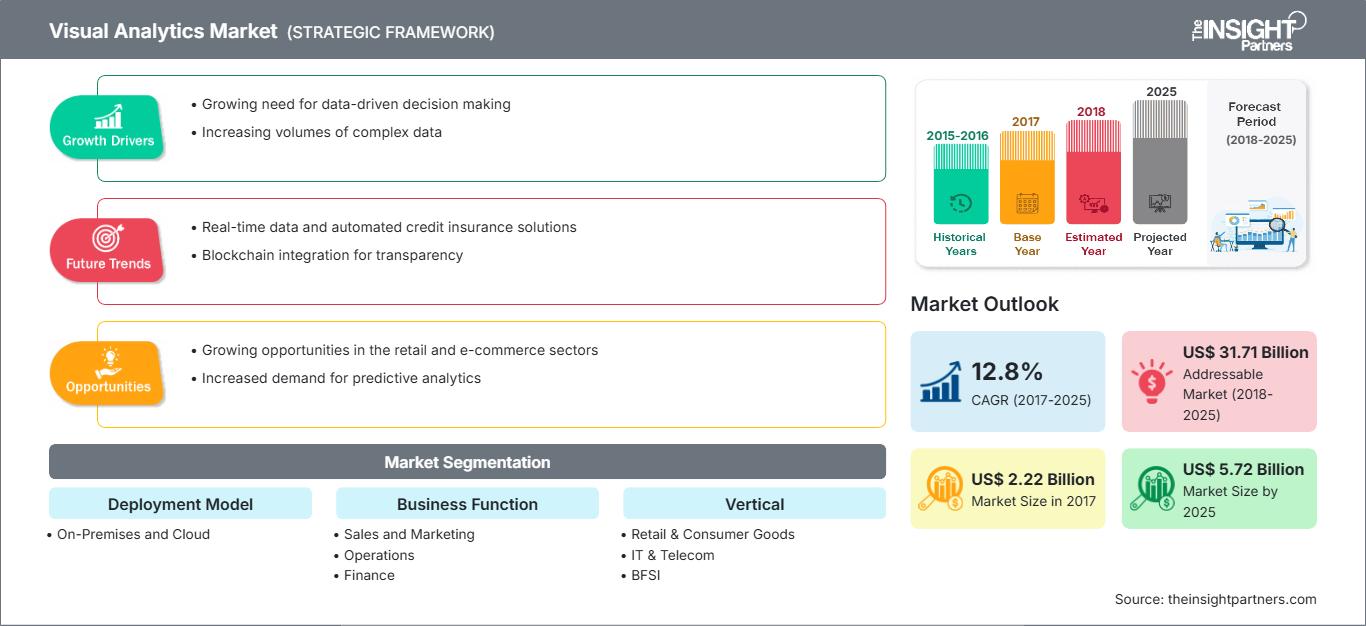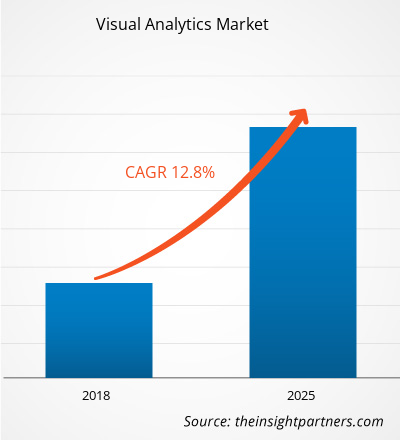[Forschungsbericht]Der Markt für visuelle Analytik wurde im Jahr 2017 auf 2.215,0 Millionen US-Dollar geschätzt und soll bis 2025 voraussichtlich 5.718,6 Millionen US-Dollar erreichen. Im Prognosezeitraum 2017 bis 2025 wird für den Markt für visuelle Analytik eine durchschnittliche jährliche Wachstumsrate (CAGR) von 12,8 % erwartet.
Das übergeordnete Ziel von Visual-Analytics-Lösungen besteht darin, Visualisierung mit interaktiver Analyse zu kombinieren, um große Datensätze zu untersuchen. Mit anderen Worten ist Visual Analytics die Wissenschaft des analytischen Denkens, die durch interaktive visuelle Schnittstellen ermöglicht wird. Genauer gesagt ist Visual Analytics ein iterativer Prozess, der Informationsbeschaffung, Datenvorverarbeitung, Wissensdarstellung, Interaktion und Entscheidungsfindung umfasst. Das ultimative Ziel besteht darin, Einblick in das vorliegende Problem zu gewinnen, das durch riesige Mengen wissenschaftlicher, forensischer oder geschäftlicher Daten aus heterogenen Quellen beschrieben wird. Um dieses Ziel zu erreichen, kombiniert Visual Analytics die Stärken von Maschinen mit denen des Menschen. Einerseits sind Methoden der Wissensentdeckung in Datenbanken (KDD), Statistik und Mathematik die treibende Kraft auf der Seite der automatischen Analyse, während andererseits die menschlichen Fähigkeiten zur Wahrnehmung, Verknüpfung und Schlussfolgerung visuelle Analytik zu einem sehr vielversprechenden Forschungsfeld machen. Heutzutage reicht Datenvisualisierung allein nicht mehr aus und die Unternehmen freuen sich auf datengesteuerte Analysefunktionen, die in ihre Datenvisualisierung integriert sind. Visuelle Analytik kann als die Bildung intellektueller visueller Metaphern kombiniert mit manueller Informationsinteraktion erklärt werden.
Der Markt für visuelle Analytik wurde auf Basis von Bereitstellungsmodell, Geschäftsfunktion und Branche segmentiert. Basierend auf dem Bereitstellungsmodell wurde der Markt für visuelle Analytik in On-Premises und Cloud segmentiert. Basierend auf der Geschäftsfunktion wurde der Markt für visuelle Analytik in Vertrieb und Marketing, Betrieb, Finanzen, Lieferkette, Informationstechnologie, CRM und Personalwesen segmentiert. Der Markt ist weiter auf Basis von Branchen segmentiert in Einzelhandel und Konsumgüter, IT und Telekommunikation, BFSI, Fertigung, Energie und Versorgung, Gesundheitswesen und Regierung. Geografisch ist der Markt in fünf Regionen fragmentiert, darunter Nordamerika, Europa, Asien-Pazifik, Naher Osten und Afrika sowie Südamerika.
Passen Sie diesen Bericht Ihren Anforderungen an
Sie erhalten kostenlos Anpassungen an jedem Bericht, einschließlich Teilen dieses Berichts oder einer Analyse auf Länderebene, eines Excel-Datenpakets sowie tolle Angebote und Rabatte für Start-ups und Universitäten.
Markt für visuelle Analysen: Strategische Einblicke

-
Holen Sie sich die wichtigsten Markttrends aus diesem Bericht.Dieses KOSTENLOSE Beispiel umfasst Datenanalysen, die von Markttrends bis hin zu Schätzungen und Prognosen reichen.
Der größte Trend, der heute Innovationen in der Datenvisualisierung und -analyse beeinflusst, ist die Verbreitung von künstlicher Intelligenz (KI) und maschinellem Lernen. Auch wenn es für IT-Abteilungen und Analysten, die die menschliche Kontrolle nur ungern abgeben, beängstigend klingen mag, werden Analyseplattformen mit KI- und ML-Funktionen modernen Analysten tatsächlich als äußerst effektive Assistenten dienen. Während die Sorge vor einer Ersetzung bestehen mag, wird maschinelles Lernen Analysten tatsächlich voranbringen und sie effizienter, präziser und wirkungsvoller für das Unternehmen machen. Anstatt die Technologie des maschinellen Lernens zu fürchten, sollten Sie die Chancen nutzen, die sie bietet.
Markteinblicke basierend auf Bereitstellungsmodellen
Visual Analytics umfasst Cloud- und On-Premise-Bereitstellungsmodelle. Das Bereitstellungsmodell für Visual Analytics ist eine wichtige Entscheidung für ein bestimmtes Modell. Unternehmen bevorzugen je nach verschiedenen Faktoren sowohl die Cloud- als auch die On-Premise-Bereitstellung. Viele KMU bevorzugen aufgrund der günstigen Preise die Cloud-basierte visuelle Analyse als optimale Bereitstellungsmethode.
Geschäftsfunktionsbasierte Markteinblicke
Ein Paradigmenwechsel in den Geschäftsansätzen hat zu steigenden Anforderungen an die Integration verschiedener Analysesoftware in die Geschäftsprozesse verschiedener Branchen weltweit und insbesondere in den fortgeschrittenen Regionen geführt. Die heutigen Geschäftsanwender haben sich von den herkömmlichen Techniken der Datenverwaltung, -verarbeitung und -analyse weiterentwickelt. Verschiedene Geschäftsfunktionen in einem bestimmten Sektor erfordern die Analyse von Daten für unterschiedliche Zwecke.
Vertikalbasierte Markteinblicke
Die grundlegende Funktion jedes visuellen Analysetools besteht darin, komplexe Daten zu erfassen und sie dem Benutzer auf eine interaktive und leicht verständliche Weise zu präsentieren. Visuelle Analysetools müssen zwei wichtige Aufgaben erfüllen: die Visualisierung und anschließende Analyse der Daten. Eine einfache Visualisierung reicht nicht aus, um große Datenmengen zu vereinfachen. Benutzerfreundlichkeit dieser Tools, Kosteneffizienz, die Möglichkeit der Anpassung von Visual-Analytics-Tools, interaktive Benutzeroberflächen, Dashboards und Filteroptionen sind einige der Parameter, die Endbenutzern bei der Auswahl eines bestimmten Visual-Analytics-Tools für ihre Geschäftsfunktion helfen.
Akteure im Visual-Analytics-Markt konzentrieren sich auf Strategien wie Marktinitiativen, Akquisitionen und Produkteinführungen, um ihre Position im Visual-Analytics-Markt zu behaupten. Einige Entwicklungen der wichtigsten Akteure des Visual-Analytics-Marktes sind:
Im September 2018 stellte TIBCO A(X) Experience für TIBCO Spotfire vor, das visuelle Analysen von Datenströmen in Echtzeit ermöglicht und so Erkenntnisse und Maßnahmen in Echtzeit ermöglicht.
Im September 2018 stellte SAP SE die SAP Analytics Cloud vor, eine einfache Cloud für alle Analysen. Diese analytische Cloud bietet ihren Kunden eine All-in-One-Integration von Datenvisualisierung, Prognose- und Planungsfunktionen.
Regionale Einblicke in den Markt für visuelle Analysen
Die Analysten von The Insight Partners haben die regionalen Trends und Faktoren, die den Visual Analytics-Markt im Prognosezeitraum beeinflussen, ausführlich erläutert. In diesem Abschnitt werden auch die Marktsegmente und die geografische Lage in Nordamerika, Europa, dem asiatisch-pazifischen Raum, dem Nahen Osten und Afrika sowie Süd- und Mittelamerika erörtert.
Umfang des Marktberichts zur visuellen Analyse
| Berichtsattribut | Einzelheiten |
|---|---|
| Marktgröße in 2017 | US$ 2.22 Billion |
| Marktgröße nach 2025 | US$ 5.72 Billion |
| Globale CAGR (2017 - 2025) | 12.8% |
| Historische Daten | 2015-2016 |
| Prognosezeitraum | 2018-2025 |
| Abgedeckte Segmente |
By Bereitstellungsmodell
|
| Abgedeckte Regionen und Länder |
Nordamerika
|
| Marktführer und wichtige Unternehmensprofile |
|
Dichte der Marktteilnehmer im Bereich Visual Analytics: Verständnis ihrer Auswirkungen auf die Geschäftsdynamik
Der Markt für Visual Analytics wächst rasant. Die steigende Nachfrage der Endnutzer ist auf Faktoren wie veränderte Verbraucherpräferenzen, technologische Fortschritte und ein stärkeres Bewusstsein für die Produktvorteile zurückzuführen. Mit der steigenden Nachfrage erweitern Unternehmen ihr Angebot, entwickeln Innovationen, um den Bedürfnissen der Verbraucher gerecht zu werden, und nutzen neue Trends, was das Marktwachstum weiter ankurbelt.

- Holen Sie sich die Markt für visuelle Analysen Übersicht der wichtigsten Akteure
- On-Premise
- Cloud
Markt für visuelle Analysen – nach Geschäftsfunktion
- Vertrieb und Marketing
- Betrieb
- Finanzen
- Lieferkette
- Informationstechnologie
- CRM
- Personalwesen
- Sonstige
Markt für visuelle Analysen – nach Branchen
- Einzelhandel und Konsumgütermarkt
- IT und Telekommunikation
- BFSI
- Fertigung
- Energie und Versorgung
- Sonstige
- Gesundheitswesen
- Behörden
Markt für visuelle Analysen – nach Geografie
-
Nordamerika
- USA
- Kanada
- Mexiko
-
Europa
- Frankreich
- Deutschland
- Spanien
- Großbritannien
- Italien
-
Asien-Pazifik (APAC)
- China
- Indien
- Japan
- Australien
-
MEA
- Saudi-Arabien
- VAE
- Südafrika
-
SAM
- Brasilien
Markt für visuelle Analyse – Unternehmensprofile: ADVIZOR Solutions, Inc., Alteryx, Inc Inc.
- Historische Analyse (2 Jahre), Basisjahr, Prognose (7 Jahre) mit CAGR
- PEST- und SWOT-Analyse
- Marktgröße Wert/Volumen – Global, Regional, Land
- Branchen- und Wettbewerbslandschaft
- Excel-Datensatz
Aktuelle Berichte
Erfahrungsberichte
Grund zum Kauf
- Fundierte Entscheidungsfindung
- Marktdynamik verstehen
- Wettbewerbsanalyse
- Kundeneinblicke
- Marktprognosen
- Risikominimierung
- Strategische Planung
- Investitionsbegründung
- Identifizierung neuer Märkte
- Verbesserung von Marketingstrategien
- Steigerung der Betriebseffizienz
- Anpassung an regulatorische Trends






















 Kostenlose Probe anfordern für - Markt für visuelle Analysen
Kostenlose Probe anfordern für - Markt für visuelle Analysen